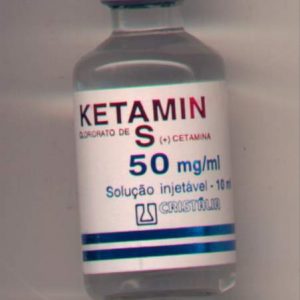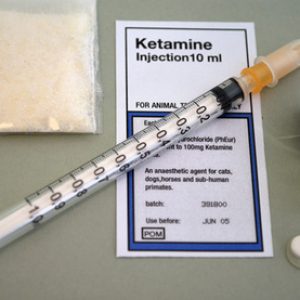Ketamine – a drug used in medicine since the early 60-ies of XX century. The drug was the opening of a new era of General anesthesia during short and emergency surgical, gynecological procedures, as well as to facilitate painful methods of instrumental diagnostics.
Especially in cases with limitation to the use of barbiturates and drugs of opioid group. The positive effect of this medication provided in cases of bronchospasm. Thanks to the accompanying psychedelic effects, among dependent people spread abuse of ketamine.
The drug includes analogs that are most known under the names – kalipsol, ketanest, ketalar.
General information
When used in many patients, the drug causes excitement and an influx of hallucinatory visions. These side effects appear particularly strong in patients with drug and alcohol addiction.
In the environment of the drug ketamine, known by the books M. Moore and G. Alltounian, which vividly described the effect of the drug on the basis of their own experience.
In practice it is used in theaters of war local wars, as well as in veterinary medicine.

In the USSR this medication has appeared with the 80-ies of the last century. And Since 90-ies he started to spread like a narcotic psychedelic means. In 1998 officially join the category of drugs in Russia.

The use of ketamine was accompanied by a number of high-profile criminal scandals.
Please note: special popular the drug got in the youth environment due to its ‘colourful’ experiences on the background of heavy opium and expensive cocaine.
As it has ketamine
The effects of the drug is based on its selective inhibition of individual sections of the cerebral cortex and thalamus. However, he delays the speed functions of the limbic system and hippocampus (causing distortion of awareness of sensations). These processes lead to disorders of the connections between the parts, especially the midbrain and thalamus. In medicine this condition is called dissociative anesthesia (in which there is a marked change in the consciousness of man). Ketamine has effects on opioid receptors, causing analgesia and appropriate accounting psychoaffective. By acting on cholinergic receptors, a substance promotes the bronchi and the development of specific delirious state.
Dose dependence and abuse of ketamine
Among drug addicts who use this substance, the most popular method of administration intramuscularly. It is considered very effective due to the “optimal” combination of dose and duration of drug effect. Intravenous use is more bright euphoria, but which lasts much less (30-60 minutes) than intramuscular injection (a few hours).
For more rare applies intranasal (inhalation) and oral (ingestion) methods of anesthesia.
The initial dose is equal to the average of 0.5-0.6 ml of 5% solution of ketamine. The slowly emerging tolerance (resistance) causes the patient to increase the dose several times.
As noted above – the main consumers of ketamine – teenagers. Initial ingestion of the drug occurs in the group. The main motive is to emulate those who have experienced it actionGroup E. form of anesthesia is the initial period of dependence. It often happens a combination of drugs and effects.
Leaving the group, only those who have experienced dangerous condition to life or health.
For the rest, the best in terms of mikrokollektiv is the only expected in the life of the incentive. Without familiar surroundings, and without drugs, the teenager begins to experience boredom, mental discomfort, emotional instability. Parents, unfortunately, notice the change in behavior of their children too late because the action of ketamine manage to finish within a few hours. Home boy or girl get to have a normal (relatively).

Please note: because the drug requires material means, that teenagers begin to steal money from my parents, and in other places.
If at this point the group time to catch the facts of addiction and theft, to identify and isolate the leader, this fellowship may be terminated, as taking the drug.
Those who continued to take the psychoactive substance, gradually developed and strengthened mental and physical dependence. Former doses do not give effect, the anesthesia is transferred on a systematic level. Teenagers are beginning to skip classes, study, lose interest in everyday life. Their attention is only one desire – acceptance of the drug.
Often the whole group moves on to harder drugs. In this case, the part of young drug addicts is reduced to a few people with already severe degree of addiction.
The manifestation of intoxicating action involves abuse of ketamine
Ketamine intoxication is subdivided into three or four phases:
- The effect of the drug manifests itself in 5-10 minutes after ingestion (consider the most common – intramuscular method of administration). The duration of phase 1 for 2-3 minutes. The patient is experiencing: relaxation (pronounced relaxing), calm, pleasant dizziness, peculiar taste sensations.
- The duration of this phase is limited to 2-4 hours. In this state the patient feels the physical and mental recovery, mood improves. In the body there is a lightness, lightness, flexibility, some derealization, which addicts call “weightlessness”. Patients think that a private body varies in size and volume.
- This phase develops in the case of receiving a dose of ketamine. Intoxication 2 phase gradually goes away and is replaced by irritability, weakness. Patients look tired, sluggish, answer the questions, they inhibited all responses. There is a feeling of lack of their own body (dysmorphophobia). Develops mental derealization, suspiciousness, ideas of persecution and fear. These manifestations are accompanied by illusory-hallucinatory experiences, vision of the paintings, hearing music. During the inspection, patients pale, the pupils expressed expanded, coordination impaired, heart rate increased by 20-30 beats, blood pressure increased steadfastly.
- Ending phase lasts 1-2 hours, and is characterized by a dramatically reduced sensitivity, which sometimes is absent. Nausea, pronounced weakness, peak coordination disorders. Gradually all the phenomena go away.
Please note! When taken regularly the first phase is almost absent, or there is a few seconds. Of the second and third phase are merged together.
After a few months the patients are taught methods of self-regulation of drug. They eliminate feelings of fear, directed hallucinations, easing, or completely eliminating the negative feelings of ketamine.
In sober moments develops a permanent form of absent-mindedness, confusion, lack of attention, memory function. Thinking loses its consistency, depth. Moral patients fall. Apparently they’re losing weight, coarse skin appear pathological rash. High blood pressure gives impetus to the development of headaches. Patients suffering from tachyarrhythmias (pronounced palpitations).
Please note: on the background of deprivation of ketamine addicts clearly show through withdrawal symptoms.
Withdrawal syndrome (abstinence)
The lack of psychoactive substances causes patients:
Dependent strongly looking into the possibility of anesthesia, begging and seeking any pretext to funds for drugs. Withdrawal syndrome lasts from days to two weeks.
Treatment of the abuse of ketamine
At the initial stages drugs no specific treatment is required. For clarification of the possible consequences of doing experienced teachers and psychologists. In some cases, may require individual sessions with the adolescent and family psychotherapy.
In more advanced cases need the intervention of experts. Outpatient treatment means medical treatment of existing mental disorders (antidepressants, tranquilizers). Disorders of the heart (increased heart attacks and high blood pressure) eliminated individual selection of the required medicines.
Please note: the adverse social conditions in the environment, pathological mental background required inpatient therapy.
The clinic conducts a thorough physical examination and most importantly – a psychological study and correction.
In the hospital there are more opportunities in terms of application of rational and group psychotherapies. Behavioural correction, astatotilapia, healing hypnosis sessions allow you to achieve a good effect. Treatment in these cases should not rush to the maximum time limit to return the patient to normal Wednesday.
The best solution will be to continue recovery in rehab with a subsequent change of place of residence, work and the surrounding society.
In severe cases of ketamine abuse requires a massive drug therapy with detoxification, the use of neuroleptics (with psychotic disorders). At the exit of the acute manifestations require restorative treatment nootropics.
The prognosis for abuse of ketamine
Outcome dependence is determined by the patient’s age, experience, environment and quality psychotherapy, treatment. Timely treatment allows to achieve a good remission or even a complete cure, subject to a life of failure from the drug.
It should be remembered that in the case of duration of the dependency period more than 1 year, in patients developing a serious chronic brain disorder, difficult to reverse development. If the experience of anesthesia exceed 3-4 years, some patients develop severe dementia, degradation of desocialization, moral emptiness, rudeness, indifference to yourself, others, loss of purpose of life. In addition to ketamine and other drugs such patients has almost nothing to worried about. In this case, a psychoactive substance ceases to give the sensation. Ill take it for the sake of maintaining sane state or move on to heavier types of drugs. In this case, the prognosis is poor.




Where can I buy over the counter in canada how much does cost per pill in canada.
With thanks! Valuable information!
After looking into a handful of the blog posts on your web site, I seriously like your way of blogging. I saved as a favorite it to my bookmark webpage list and will be checking back in the near future. Please check out my web site as well and tell me what you think.
Dose dependence and abuse of ketamine
Really enjoyed this blog.Much thanks again. Great.
These processes lead to disorders of the connections between the parts, especially the midbrain and thalamus. In medicine this condition is called dissociative anesthesia (in which there is a marked change in the consciousness of man).
It’s an remarkable article designed for all the internet people;
they will get advantage from it I am sure.